List of Contents
What is Leadless Pacemakers Market Size?
The global leadless pacemakers market size is calculated at USD 748.36 million in 2025 and is predicted to increase from USD 787.28 million in 2026 to approximately USD 1181.01 million by 2034, expanding at a CAGR of 13.74% from 2025 to 2034. The increased prevalence of cardiac conditions and aging populations are the major factors driving the growth of the leadless pacemakers market. Government investments and private insurance coverage are driving adoptions of leadless pacemakers.
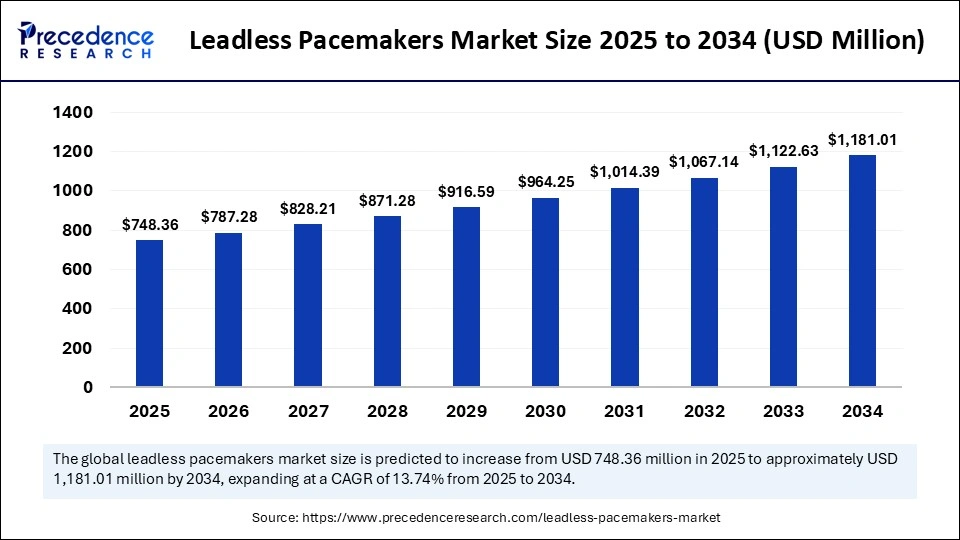
Market Highlights
- North America dominated the leadless pacemakers market with the largest revenue share of 55% in 2024.
- Asia Pacific is expected to grow at a fastest CAGR of 15.2% from 2025 to 2034.
- By pacing chamber, the single chamber segment held the major revenue share of 56% in 2024.
- By pacing chamber, the dual chamber segment is expected to grow at the fastest rate from 2025 to 2034.
- By end-use, the inpatient facilities segment contributed the highest revenue share of 89% in 2024.
- By end-use, the outpatient facilities segment is expected to grow at the fastest rate between 2025 and 2034.
What are the Substantial Technological Advances in the Leadless Pacemakers?
A leadless pacemaker is a small, single-piece device that is inserted into the heart to regulate heartbeats. Leadless pacemakers don't require a lead to connect the leads in the heart. Factors like increased demand for personalized medicines and minimally invasive procedures are the key factors contributing to the market expansion. The rising incidence of cardiovascular disease and an aging population contribute to market growth. The growing emphasis on patient-centric care is driving the demand for such devices by healthcare providers to enhance patient outcomes and quality of life.
Technological advancements like remote monitoring and wireless connections are driving the safety and efficacy of leadless pacemakers. Adoption of cutting-edge technologies is enabling access to advanced leadless pacemakers. For example, innovations and developments of advanced dual-chamber leadless pacemakers are the key trends in the market. The implementation of AI-driven leadless pacemakers is projected to bring significant transformative movements for the market in the upcoming period.
AI Implementation in Leadless Pacemakers
Integrating AI algorithms in leadless pacemakers leads to precise and personalized pacing strategies. AI algorithms help to improve the capabilities of leadless pacemakers and improve healthcare facilities. AI algorithms are enabling tailored pacemaker therapy for individual patients, reducing complications and improving treatment results. The development of personalized medicine, such as patient-specific therapy and data-driven insights, has become possible thanks to AI integration. The growing emphasis on early detection of complications is driving the popularity of AI implementation in leadless pacemakers.
Leadless Pacemakers MarketGrowth Factors
- The rising prevalence of heart-related disease is the major factor driving the demand for leadless pacemakers. A growing ageing population supports market growth, as older adults are more prone to cardiovascular diseases.
- The increase in demand for minimally invasive procedures to reduce recovery time, pain, and the risk of complications is driving a shift toward leadless pacemakers.
- Technological advancements such as miniaturization and wireless connectivity are enabling the development of smaller and more implementable leadless pacemakers.
- Expanding healthcare infrastructure and rising healthcare expenditures also play a pivotal role in the adoption of leadless pacemakers.
Leadless Pacemakers Market Outlook:
- Global Expansion: Prominent technological advances in dual-chamber systems, a rise in the geriatric population, and the advantages of minimally invasive procedures are assisting the overall expansion.
- Major Investors: Such as Boston Scientific, EBR Systems, and others are actively investing in the technology's development.
- Startup Ecosystem: VoltXon, a U.S.-based startup offering a battery-free pacemaker by using proprietary graphene-based technology to harvest energy from the patient's body.
Market Scope
| Report Coverage | Details |
| Market Size in 2025 | USD 748.36 Million |
| Market Size in 2026 | USD 787.28 Million |
| Market Size by 2034 | USD 1181.01 Million |
| Market Growth Rate from 2025 to 2034 | CAGR of 13.74% |
| Dominating Region | North America |
| Fastest Growing Region | Asia Pacific |
| Base Year | 2024 |
| Forecast Period | 2025 to 2034 |
| Segments Covered | Pacing Chamber, End-use, and Region |
| Regions Covered | North America, Europe, Asia-Pacific, Latin America, and Middle East & Africa |
Market Dynamics
Drivers
Increased Prevalence of Cardiovascular Diseases
The increased prevalence of cardiovascular diseases (CVDs) worldwide is a key factor driving the growth of the leadless pacemakers market. The increased risk of atrial fibrillation, heart failure, and other cardiac conditions is boosting the demand for leadless pacemakers. Leadless pacemakers are minimally invasive treatment solutions that are suitable for patients with complex cardiac conditions. Another factor boosting the adoption of leadless pacemakers is an aging population and a high risk of heart disease in this population. The rising awareness among healthcare professionals and patients alike about the benefits of leadless pacemakers in reducing complications and enhancing patient outcomes is boosting the growth of the market.
Restraint
High Cost
The high costs associated with leadless pacemakers are a major hindrance to the market. Leadless pacemakers are more expensive than traditional pacemakers, limiting their adoption. The implementation procedure of leadless pacemakers is complex and requires skilled knowledge, affecting the market's growth. Moreover, limited reimbursement policies for leadless pacemakers increase the overall cost of the procedure, which restrains the growth of the market.
Opportunity
Technological Advancements
Technological advancements create immense opportunities in the leadless pacemakers market. Technological innovations enable the development of more compact, efficient, and minimally invasive leadless pacemakers. Newly developed leadless pacemakers are designed with longer battery life to reduce frequent replacement surgeries. Ongoing advancements in wireless technology allow remote monitoring of pacemaker performance and enable real-time adjustments, improving convenience and the cost-effectiveness of leadless pacemakers. The demand for less invasive and safer alternatives to traditional pacemakers has increased among patients with complex medical conditions, driving the demand for next-generation lead pacemakers.
Segment Insights
Pacing Chamber Insights
The single chamber segment contributed the largest revenue share of 56% in 2024 due to its wide applicability. Single-chamber leadless pacemakers have a straightforward design that helps reduce complexity and the risk of complications. These chambers treat most bradycardia cases with single-site pacing in the right ventricle or atrium. These chambers require few leads and less surgical time, making implementation easier. Additionally, the cost-effectiveness of single chambers makes them ideal and more accessible to patients.
- In November 2024, Abbott launched the AVEIR VR, a single-chamber ventricular leadless pacemaker, in India. The device received approval from the Central Drugs Standard Control Organisation (CDSCO).
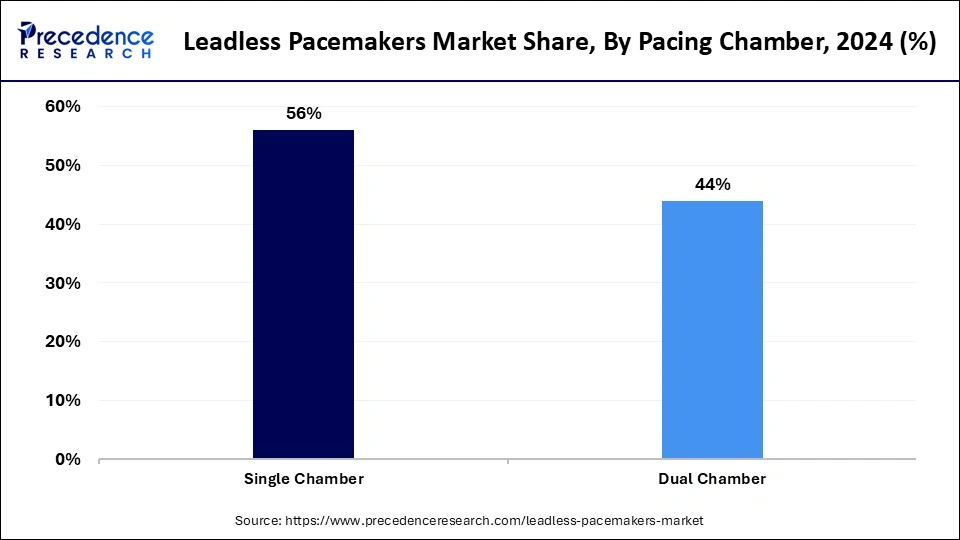
Meanwhile, the dual chamber segment is expected to grow at the fastest rate in the upcoming period. Dual chambers allow the treatment solution for large patient populations with cardiac conditions. Technological advancements, such as synchronized pacing, are improving the capabilities of dual-chamber lead pacemakers for better heart rhythm control, improving exercise capacity and patient outcomes. Additionally, the rising demand for minimally invasive implantations for cardiac pacing is expected to support segmental growth.
End-use insights
The inpatient facilities segment dominated the market by holding more than 80% of revenue share in 2024. Inpatient facilities provide specialized care and treatment solutions for patients with cardiac disorders. These facilities perform large volumes of procedures due to the availability of advanced imaging solutions, skilled electrophysiologists, and a sterile operating room environment, which makes them ideal settings. Increased reimbursements for leadless pacemakers for inpatient facilities further bolstered the segmental growth.
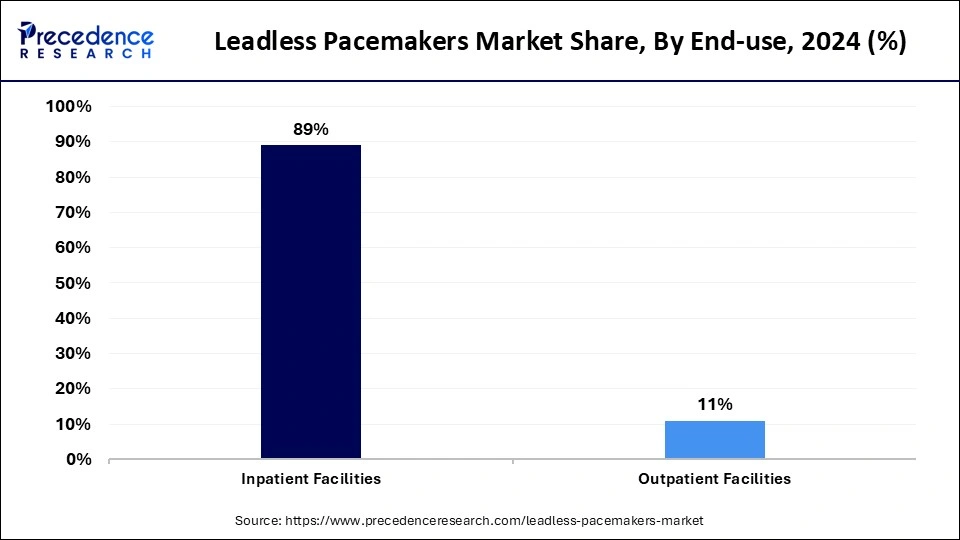
On the other hand, the outpatient facilities segment is expected to grow at the fastest rate in the coming years because of its ability to provide minimally invasive procedures. The leadless pacemaker procedures performed in outpatient facilities reduce healthcare costs. Convenient and accessible care in outpatient facilities makes them popular among patients. Furthermore, the reduced need for hospitalization encourages patients to perform a leadless pacemaker procedure in outpatient facilities.
Regional Insights
U.S. Leadless Pacemakers Market Size and Growth 2025 to 2034
The U.S. leadless pacemakers market size is exhibited at USD 378.67 million in 2025 and is projected to be worth around USD 605.21 million by 2034, growing at a CAGR of 5.33% from 2025 to 2034.
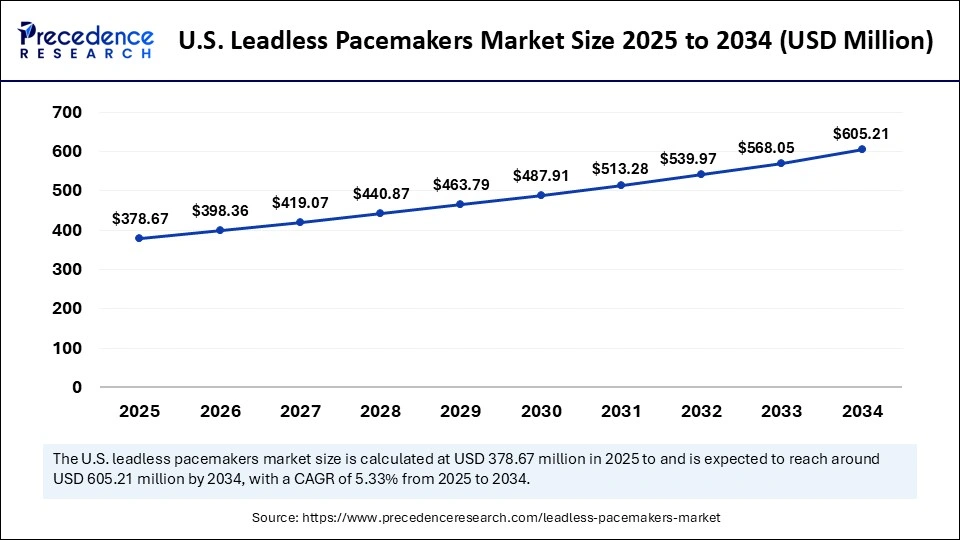
How did North America Dominate the Market in 2024?
North America generated the highest revenue share of 55% in 2024. The increased prevalence of cardiovascular disease and an aging population in the region are key factors contributed to the region's market dominance. The region's advanced healthcare infrastructure and high adoption rate of cutting-edge technologies further bolstered the growth of the market. There is a high adoption rate of leadless pacemakers due to the increased popularity of minimally invasive procedures. Furthermore, reimbursement policies for healthcare devices ensure the long-term growth of the market in the region.
Rising Efforts into Innovations: U.S. Market Trend
The U.S. leads the market for leadless pacemakers due to the increasing number of cases of heart disease. Rising investments in research and development, surging innovations, and the development of cutting-edge devices like leadless pacemakers are supporting the growth of the market in the country. The rising demand for minimally invasive procedures is the major factor contributing to the high adoption of leadless pacemakers in the country.
- In March 2024, MicroPort CRM, a pioneer in the field of Cardiac Rhythm Management, announced the first implantation of its ALIZEA Bluetooth 1 pacemaker system, a combination of the ALIZEA pacemaker generator and VEGA pacing leads, in the U.S. The procedure was completed by Doctor Jerry Floro at PIH Health Downey Hospital in Downey, California.
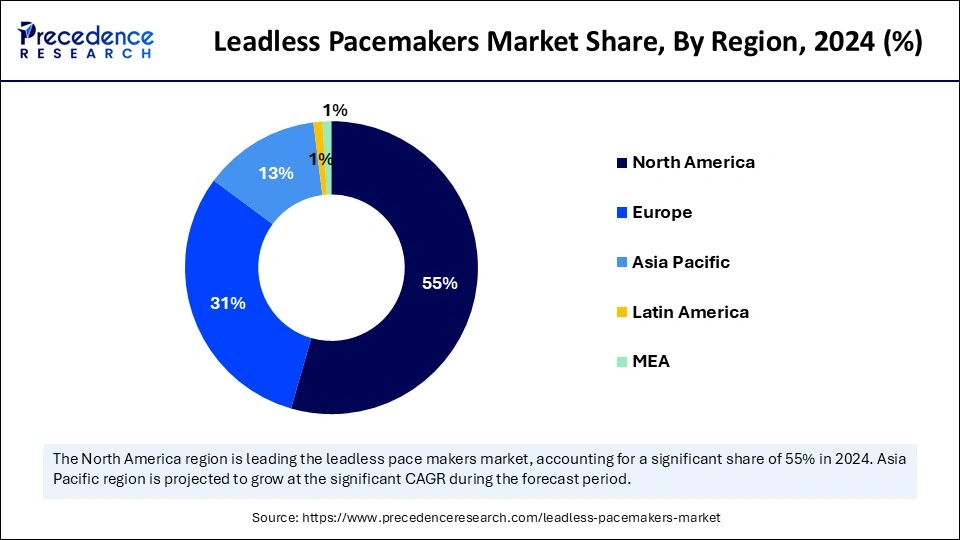
Well-developed Healthcare Infrastructure is Driving the Asia Pacific
Asia Pacific is expected to witness the fastest growth in the market in the upcoming period due to an aging population and rising incidence of heart-related diseases. Rising government investments in advancing healthcare infrastructure and regulatory support to reduce cardiovascular disease prevalence are supporting the regional market growth. China is a major player in the market, with its largest patient pool. There is a high demand for minimally invasive procedures in the country, contributing to the growth of the market.
- In February 2024, the latest generation transvenous MR-conditional safe implantable pacemaker system of MicroPort CRM received approval in China.
Ongoing Government Initiatives: Indian Market Trend
India plays a key role in the leadless pacemakers market in Asia Pacific. The growing aging population and increasing incidence of cardiovascular diseases in the country are boosting the growth of the market. Moreover, rising government initiatives to improve access to advanced healthcare services, especially in rural areas, are expected to support the market's growth.
- In January 2025, Doctors of a private hospital in Chennai, India, implanted Abbott AVEIR VR, a state-of-the-art, and artificial intelligence (AI)-driven, leadless pacemaker in an 86-year-old woman. This AI-driven leadless pacemaker is designed to treat patients with slow heart rhythms. The device was directly implanted into the heart's right ventricle to reduce the risk of infections, lead dislodgement, and other complications.
Rise in Healthcare Spending is Fueling Europe
Europe is anticipated to witness notable growth. The growth of the leadless pacemakers market in the region can be attributed to its well-established healthcare system and high healthcare expenditure. The region is an early adopter of leadless pacemakers. Germany is a major market in the region. There is a high adoption of cutting-edge technologies. The rising instances of CVDs are boosting the growth of the market.
Germany's Miniature Pacer Uptake Surge
Germany's leadless pacemaker market is rapidly expanding, fueled by rising demand for minimally invasive alternatives to traditional devices. Favorable reimbursement policies, an aging demographic, and advanced technology are driving significant, consistent growth in adoption across the nation.
Highlighted Inconsistency in Access is Promoting Latin America
A lucrative growth in the Latin American market is specifically driven by a January 2025 report, which has shown crucial discrepancies in access to electrophysiology services and specialists across various Latin American countries, demonstrating an area for prospective development and market penetration.
Immersive Dual-Chamber Pacing: Brazilian Market Trend
The respective country market is bolstering the progression of dual-chamber leadless pacemakers, like Abbott's AVEIR DR system (approved in other regions, and clinical trial data shared in 2025), which utilises wireless communication between two devices (one in the atrium, one in the ventricle) to gain synchrony, escalating the possible patient population for leadless technology.
Leadless Pacemakers Market: Value Chain Analysis
- R&D
This mainly involves an extensive process, from initial concept and design through preclinical testing, clinical trials, regulatory approval, and finally to market availability and post-market surveillance.
Key Players: Abbott Laboratories, Medtronic, Boston Scientific Corporation, etc. - Clinical Trials & Regulatory Approvals
Through Phases I to IV, numerous players are exploring the safety and effectiveness of these pacemakers, and ultimately, post-approval studies (PAS) are encompassed in this stage.
Key Players: US FDA, Abbott Medical Devices, Universitaire Ziekenhuizen KU Leuven, etc. - Patient Support & Services
Diverse hospitals and clinics are facilitating pre- and post-procedure care, follow-up monitoring, and online consultations, like Apollo 24/7.
Key Players: Medtronic, Abbott Laboratories, Cleveland Clinic Main Campus, etc.
Leadless Pacemakers Market Companies
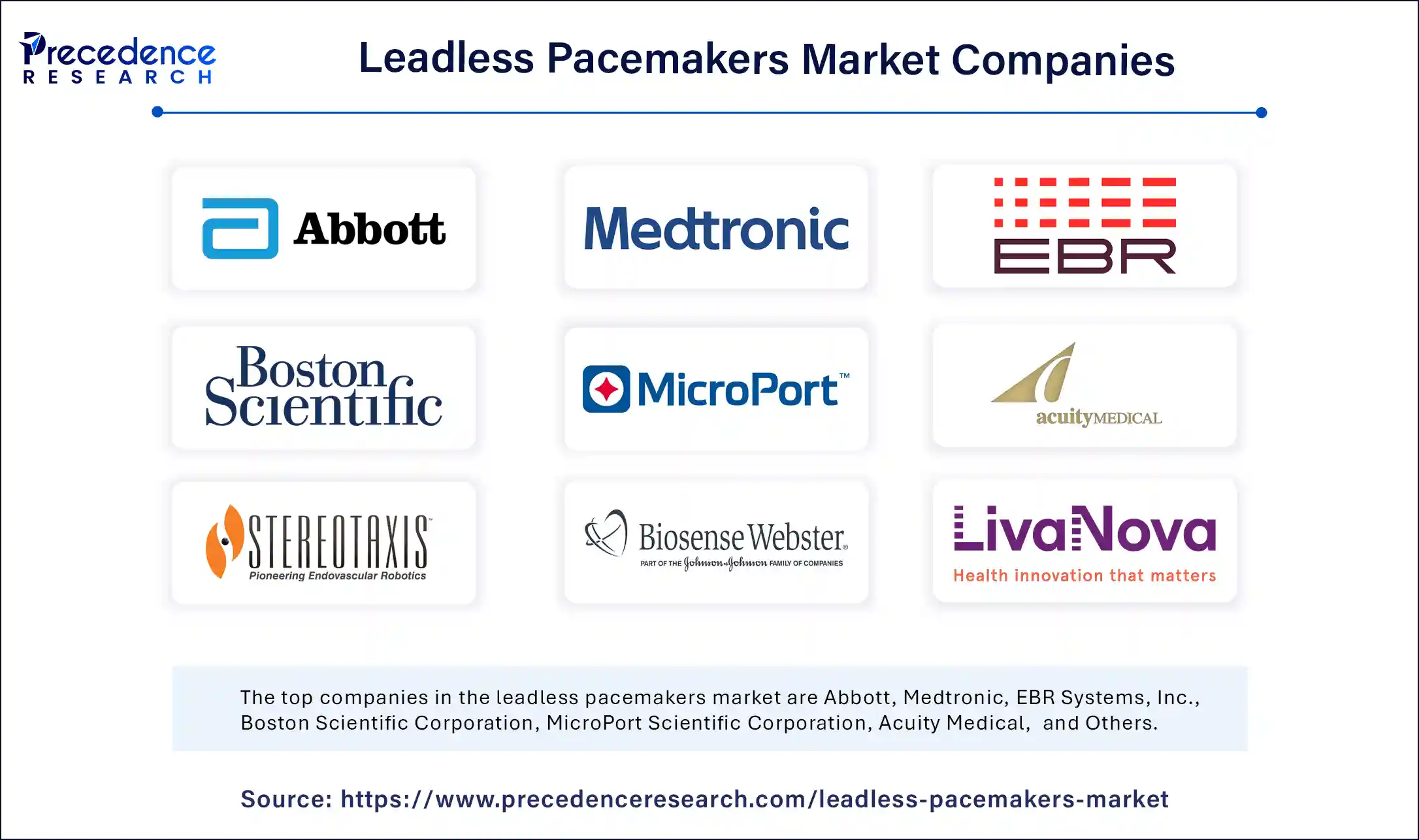
- Abbott
- Medtronic
- EBR Systems, Inc.
- Boston Scientific Corporation
- MicroPort Scientific Corporation
- Acuity Medical
- Stereotaxis
- Biosense Webster
- LivaNova
- Biotronik
- Cardiac Science
Latest Announcements by Industry Leaders
- In November 2024, Ajay Singh Chauhan, General Manager for Abbott's Cardiac Rhythm Management business in India, Southeast Asia, HK, Taiwan & Korea, said that the AVEIR VR leadless pacemaker was created to implant and make retrieval processes more seamless for physicians and deliver enhancements over existing options.
- In March 2024, Doctor Jerry Floro at PIH Health Downey Hospital in Downey, announced that the Alizema pacemaker system will play a pivotal role in providing clinical benefit, safety, and convenience for patients, with its remarkable longevity, advanced algorithms, and mobile remote monitoring.
Recent Developments
- In January 2024, Medtronic plc, a global leader in healthcare technology, received the CE (Conformité Européenne) Mark for its next generation of its industry-leading miniature, leadless pacemakers, Micra AV2 and Micra VR2. These pacemakers are the world's smallest pacemakers, designed to provide longer battery life and easier programming.
- In July 2023, Abbott received the U.S. Food and Drug Administration (FDA) approval for its AVEIR, the world's first dual-chamber leadless pacing system to treat patients with abnormal or slow heart rhythms.
Segment Covered in the Report
By Pacing Chamber
- Single Chamber
- Dual Chamber
By End-use
- Inpatient Facilities
- Outpatient Facilities
By Region
- North America
- Asia Pacific
- Europe
- Latin America
- Middle East & Africa
For inquiries regarding discounts, bulk purchases, or customization requests, please contact us at sales@precedenceresearch.com
Frequently Asked Questions
Ask For Sample
No cookie-cutter, only authentic analysis – take the 1st step to become a Precedence Research client



